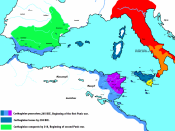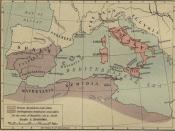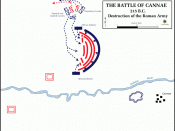In 264 B.C.; as Rome started expansion, they began conquering neighboring territories. After Rome's victory over one of its neighbors, Rome would either give them citizenry or that area would become one of Rome's allies. Incorporating citizenship in areas of which Rome had defeated was the secret of Rome's success in accomplishing expansion. By 264 B.C., all of Italy was under Roman territory, but this meant further expansion of Rome would lead to direct conflict with the great Mediterranean power of the west, Carthage. This would result in the first Punic war, which would last from 265 to 241 B.C. This was a costly, long, bloody war that Rome would win through persistence. The war quickly turned into a war at sea; Rome had little experience in sea warfare. However, Rome had found a wrecked Carthaginian warship and used it as a model to produce their navy. Rome quickly came up with ways to apply land tactics to sea warfare; an example of this would be the massive gang plank used to board enemy ships.
In 241 B.C., the Carthaginian commander, Hamilacr Barca surrendered to Rome because Rome could afford to produce one more fleet then Hamilacr Barca.
Hamilacr Barca's son-in-law, Hasdrubal, and his son, Hannibal, pushed Rome to war in 218 B.C.; the second Punic war had begun. As soon as war was declared, Hannibal began an epic march north of Spain with an army that included 38,000 infantry, 8000 calvary, and 37 war elephants. The harsh weather conditions had taken its toll on Hannibal's army. In spite of all hardships he arrived in northern Italy with more than 23,000 troops and 18 war elephants. In the first engagement between the Cartridge and Rome on the Trebia River in the Po Valley, the Romans lost two thirds (20,000) of...


